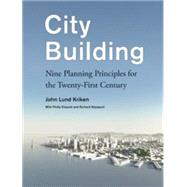
Note: Supplemental materials are not guaranteed with Rental or Used book purchases.
Purchase Benefits
What is included with this book?
| Foreword | p. ix |
| Preface | p. xi |
| An Introduction to City Building | |
| The Millennial City | p. 1 |
| The Missing Elements of City Design | p. 4 |
| A Brief (and Personal) History of Urban Design Theory and Practice | p. 9 |
| The Role of Design in Today's City Building | p. 14 |
| Nine Principles for Twenty-First-Century City Building | |
| Introduction | p. 27 |
| Sustainability | p. 28 |
| Committing to an Environmental Ethic | |
| Creating a Framework for Sustainable Settlement | p. 32 |
| Choosing the Right Future | p. 37 |
| Expanding a City/Sustaining Green | p. 44 |
| Guiding a Nation to a Post-Petroleum Future | p. 50 |
| Accessibility | p. 56 |
| Facilitating Ease of Movement | |
| Locating Corridors to Preserve a Downtown | p. 63 |
| Creating Essential Access to Major Development | p. 66 |
| Planning for Ferry Transit | p. 71 |
| Learning from Mistakes: Mixed-Access Streets versus Transit Malls | p. 76 |
| Unblocking Movement | p. 80 |
| Restoring Access, Reversing Vacancy and Decline | p. 83 |
| Diversity | p. 88 |
| Maintaining Variety and Choice | |
| Bringing Diversity to the Capitol | p. 93 |
| Designing Diversity into City Expansion | p. 96 |
| Creating Variety within Uniform Residential Regulations | p. 101 |
| Identifying the Special Qualities of a Place | p. 104 |
| Building-in Diversity | p. 108 |
| Open Space | p. 112 |
| Regenerating Natural Systems to Make Cities Green | |
| Greening the World's Densest City | p. 118 |
| Unpaving a River | p. 121 |
| Topping Off the Burnham Plan with a Green Roof | p. 125 |
| Developing a Public Greenbelt and Shoreline | p. 130 |
| Compatibility | p. 134 |
| Maintaining Harmony and Balance | |
| Protecting Heritage While Creating Identity | p. 140 |
| Protecting Heritage While Managing Density | p. 144 |
| Retaining a Rural Landscape | p. 147 |
| Reviving Block Patterns and Building Types | p. 149 |
| Incentives | p. 152 |
| Renewing Declining Cities/Rebuilding Brownfields | |
| Restoring a River (and Regenerating a City) | p. 156 |
| Rebuilding Downtowns in a Suburban Context: Good Intentions Get Snagged | p. 161 |
| Incentivizing a Brownfield | p. 164 |
| Adaptability | p. 168 |
| Facilitating "Wholeness" and Positive Change | |
| Planning for Continuous Change | p. 175 |
| Guiding and Anticipating Growth with Principles | p. 178 |
| Recovering a Diamond in the Rust (Belt) | p. 183 |
| Fitting Inside with Outside | p. 187 |
| Working toward a Flexible Campus | p. 190 |
| Density | p. 192 |
| Designing Compact Cities with Appropriate Transit | |
| Using Brown, Saving Green: Urban Density for Regional Renewal | p. 195 |
| Accepting Density and Height | p. 202 |
| Taking Advantage of Existing Infrastructure | p. 206 |
| Identity | p. 210 |
| Creating/Preserving a Unique and Memorable Sense of Place | |
| Developing Identity in Response to Climate | p. 219 |
| Responding to Climate and Culture | p. 225 |
| Creating a New Downtown Identity | p. 230 |
| Harnessing the Potential of the Waterfront | p. 234 |
| The City of the Future/The Future of the City | |
| The City Is the Solution (Not the Problem) | p. 239 |
| A New Urban Model | p. 239 |
| A Developmental Moore's Law | p. 240 |
| Learning from Asia | p. 240 |
| The Need for a Framework for Settlement | p. 241 |
| Refocusing Planning Theory and Practice | p. 245 |
| Rethinking Single-Purpose Design Education and Problem Solving | p. 245 |
| A Call for National Plans | p. 246 |
| Conclusion | p. 246 |
| Project Credits | p. 247 |
| Index | p. 254 |
| Table of Contents provided by Ingram. All Rights Reserved. |
The New copy of this book will include any supplemental materials advertised. Please check the title of the book to determine if it should include any access cards, study guides, lab manuals, CDs, etc.
The Used, Rental and eBook copies of this book are not guaranteed to include any supplemental materials. Typically, only the book itself is included. This is true even if the title states it includes any access cards, study guides, lab manuals, CDs, etc.